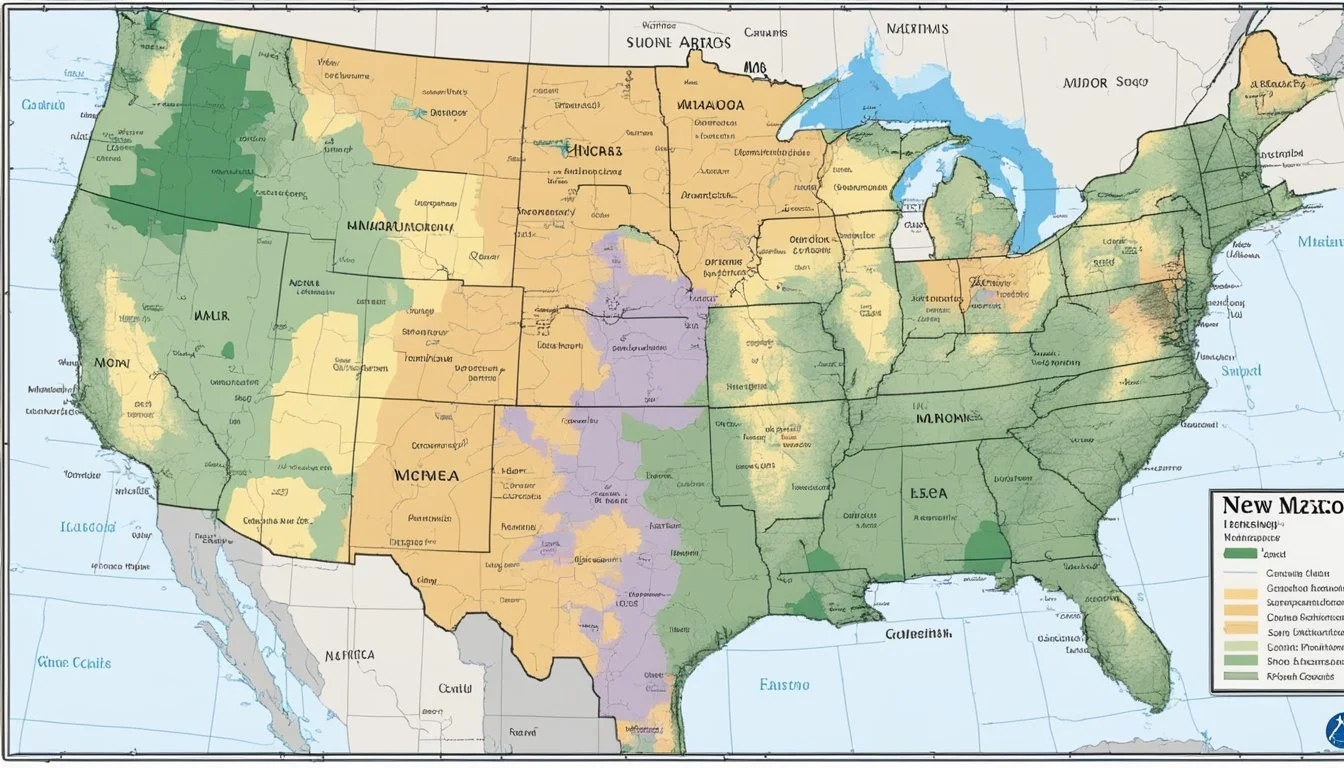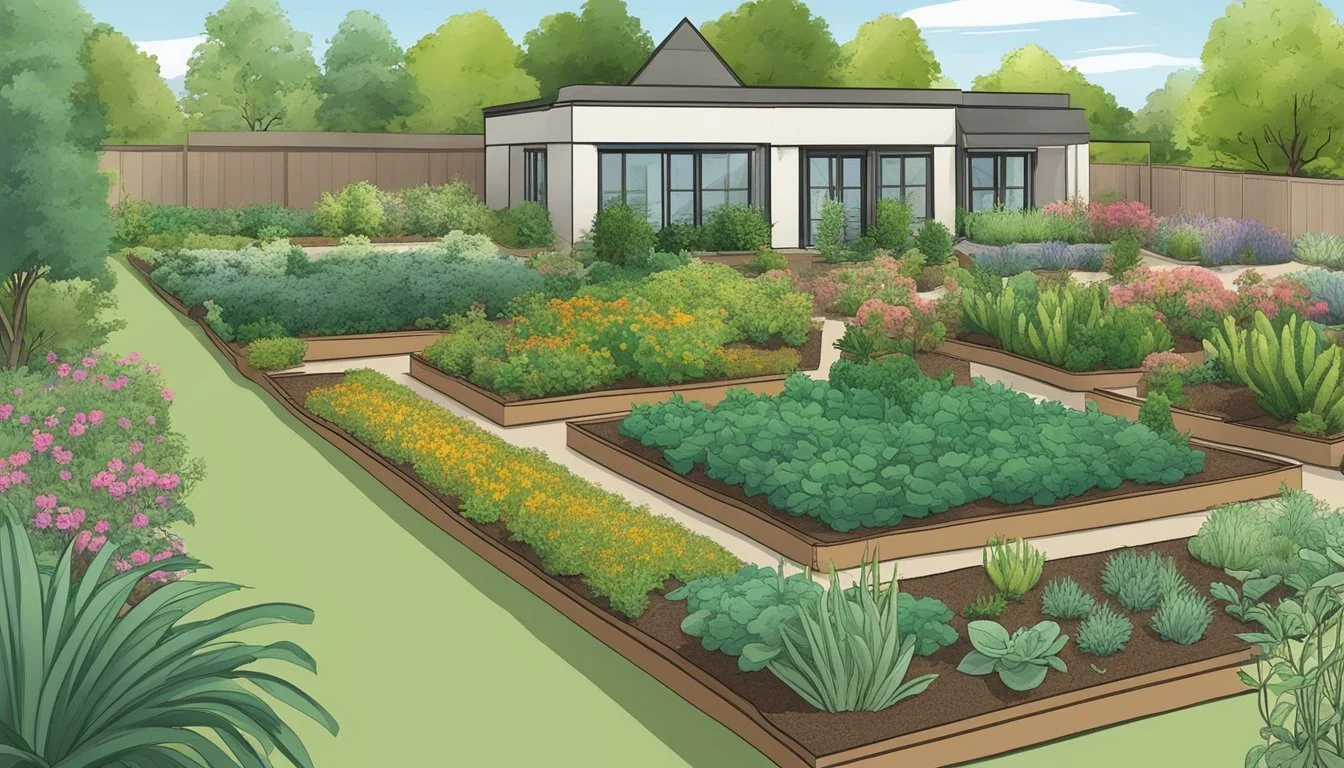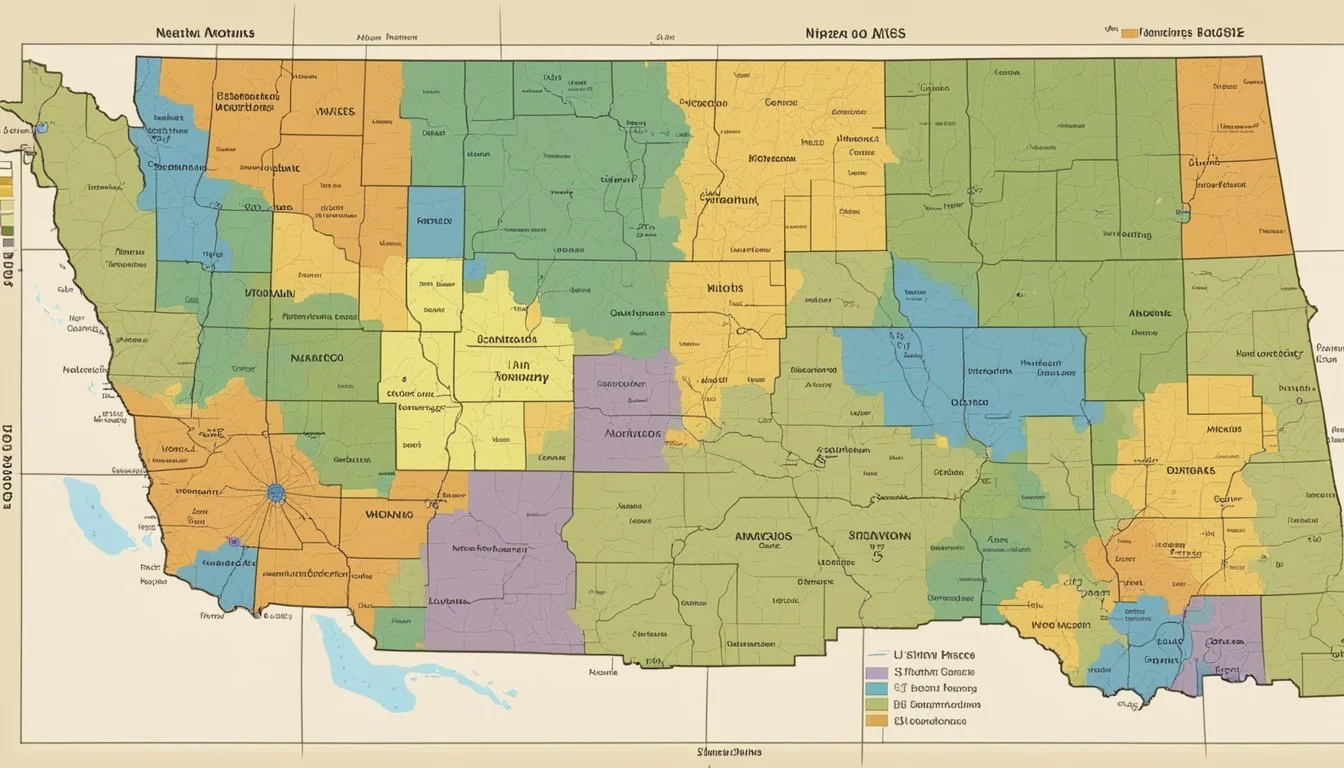USDA Hardiness Zones in New Mexico
A Guide to Planting Success
Understanding the USDA Plant Hardiness Zone Map is crucial for gardeners and growers in New Mexico. This map, updated for 2023 by the USDA, is essential in helping determine which plants are most likely to succeed in a given location. The zones on the map are delineated by the average annual extreme minimum winter temperature, broken into 10-degree Fahrenheit zones and further divided into 5-degree Fahrenheit half zones for more precise guidance.
In New Mexico, the climate varies significantly across the state, from mountainous regions to arid deserts. The 1990 USDA Hardiness Zone Map has been an important tool, revealing a range of zones from 4b, indicative of colder climates, to 8b, associated with milder temperatures. However, recent climate data has led to updated maps that reflect the shifting patterns, ensuring that both amateur and professional horticulturists have the most current information.
Data collected from numerous weather stations across the United States support the USDA plant hardiness maps, making them reliable for New Mexico residents. These modern maps account for climate changes and longer spans of weather data, spanning a thirty-year period, unlike the previous versions' fifteen-year benchmark. This advancement offers a more accurate, detailed understanding of local microclimates, improving the success rate of perennial plantings across the diverse landscapes of New Mexico.
Understanding USDA Hardiness Zones
The USDA Plant Hardiness Zone Map is a crucial tool developed by the U.S. Department of Agriculture for gardeners and cultivators across the United States. This map segments the country into various hardiness zones based on the average annual extreme minimum winter temperature. The purpose is to assist in identifying which perennial plants are best suited to withstand the local climate and temperatures.
Hardiness zones are delineated by 10-degree F zones, each of which is further divided into 5-degree F half zones. The classification informs growers about the temperature extremes in which a plant is expected to survive. For example, a hardiness zone rating of 5a indicates an area where winter temperatures can descend to -20°F to -15°F, whereas 5b represents regions experiencing lows between -15°F to -10°F.
In New Mexico, the USDA hardiness zones range from:
Zone 4b (with extreme temperatures of -25°F to -20°F)
to Zone 8b (where the climate dips only to 15°F to 20°F).
These zones reflect New Mexico's diverse climates, from snowy mountains to arid deserts. The USDA updates these zones as needed to reflect changes like warming trends. Gardeners can refer to the USDA Plant Hardiness Zone Map to find their specific zone and make informed decisions about their garden selections.
The USDA Plant Hardiness Zone Map for New Mexico
The USDA Plant Hardiness Zone Map serves as an essential guide for gardeners and growers in New Mexico, delineating regions where specific plant life is most likely to thrive. It reflects the average annual minimum winter temperatures across the state.
Overview and Importance
The USDA Plant Hardiness Zone Map is an indispensable tool for horticulture in New Mexico. This region-specific map determines the most suitable perennial plants for cultivation by categorizing areas into zones based on their average annual extreme minimum temperatures. Understanding these zones helps in making informed decisions about which plants are appropriate for a particular location, thus contributing to successful gardening and agricultural planning.
Map Download Resources
Gardeners and researchers can access the latest USDA Plant Hardiness Zone Map through several online platforms. An updated version of the map with detailed, zoomable features is available at the USDA website. Additionally, interactive state-specific maps can be found on New Mexico’s interactive zone map, which provides a digital representation of zones across the state.
Cities and Zones in New Mexico
New Mexico’s diverse climate results in a variety of hardiness zones throughout the state:
Albuquerque: Generally falls within Zone 7b, indicating average minimum temperatures of 5°F to 10°F.
Aztec and Bloomfield: These cities typically range from Zone 5b to 6a, reflecting cooler average minimum temperatures from -15°F to -5°F.
The zones are defined so that they can correspond to specific zip codes, making it easier for residents to determine the plants best suited for their gardens. For example, an Albuquerque resident in the 87101 zip code can quickly see which plants are likely to flourish in their locality.
Incorporating Hardiness Zones into Gardening
In New Mexico, understanding USDA Hardiness Zones is pivotal for fostering a thriving garden as they guide gardeners on selecting plants that are most likely to endure the local climate.
Gardening Strategies Based on Zones
New Mexico's varied climate demands that gardeners pay close attention to the specific planting zone they reside in. The state's zones range widely, which can significantly impact gardening strategies. For example, a gardener in the northern regions of New Mexico, where zones may be as cool as zone 4, will need to implement strategies for frost protection and select cold-hardy perennials.
In contrast, southern regions may experience zones up to 9, where water conservation and heat tolerance are key. Utilizing mulch and choosing plants that are drought-resistant can be beneficial practices in these warmer areas. It's essential for gardeners to map out their garden areas with respect to sun exposure, wind patterns, and topography, all of which influence a microclimate within the broader zone.
Selecting Plants for New Mexico Climates
When selecting perennial plants and flowers for a New Mexico garden, the planting zone information becomes indispensable. For colder zones, selections such as Russian Sage and various species of Echinacea flourish, as they are adapted to withstand harsh winters and periodic droughts.
In warmer zones, plants like Autumn Sage and Desert Willow are fitting choices, offering vibrant flowers and resilience in face of the prolonged heat. Each plant’s ability to thrive is dependent on its compatibility with the zone’s average minimum temperatures; hence, gardeners must consider this when planning their landscape. The USDA Unveils Updated Plant Hardiness Zone Map provides an authoritative guide for matching perennial plants with the zones of New Mexico.
Technical Aspects of Zone Mapping
The establishment of USDA Hardiness Zones in New Mexico is an intricate process combining geographic information system (GIS) technology with comprehensive climate data. Precision in this scientific undertaking is paramount, as it guides both gardeners and professionals in informed decision-making for planting and research.
GIS and Climate Data
GIS serves as the backbone in the mapping of plant hardiness zones. Through this technology, they spatially analyze climate patterns across New Mexico, layering a multitude of datasets to visualize temperature extremes, variations, and trends. The Agricultural Research Service collaborates with entities such as the PRISM Climate Group at Oregon State University to refine these datasets, ensuring that the map reflects current climatic conditions with geographic specificity.
Weather Station Contributions
Contributions from weather stations are integral to the accuracy of these maps. Individual stations provide raw, localized data on temperature fluctuations, which then feed into the broader dataset. By incorporating observations from numerous weather stations across New Mexico, the Agricultural Research Service ensures that their map captures the diverse microclimates within each hardiness zone. This collaborative effort results in a tool that can be trusted by those engaged in agriculture and horticulture to make critical planting and planning decisions.
Impact of Microclimate and Elevation
In New Mexico, microclimate variations are significant in determining plant survivability and gardening success. Due to the state's varied topography, elevation plays a pivotal role in establishing these microclimates. As one travels higher in elevation, average temperatures generally decrease, altering the USDA Hardiness Zones one may find on a map.
Elevation affects not only temperature but also wind patterns, which can differ drastically within short distances. For example, the higher elevations of the San Juan region experience different wind patterns that can either impede or accelerate plant growth compared to lower surrounding areas.
Microclimates within New Mexico can be particularly unique due to the combination of elevation and local topography. Areas protected from wind or that receive more sunlight may be warmer, thereby creating a small zone more favorable for certain plants that would not thrive just a few miles away.
Gardeners and researchers alike must consider these factors for successful cultivation. The regional variation across the state implies that plant hardiness may shift subtly within short distances, necessitating a deeper understanding of one's local growing conditions. In such diverse terrain, local knowledge and experience become invaluable for adapting gardening practices to microclimate conditions influenced by elevation and regional peculiarities.
Hardiness Zone Updates and Changes
The United States Department of Agriculture (USDA) has released an updated Plant Hardiness Zone Map, the first revision since the 2012 map. This update reflects the latest climate patterns and offers key insights for gardeners and researchers in New Mexico and nationally.
Increased Zones: Certain areas in New Mexico have experienced a shift to warmer hardiness zones.
Half-Zone Increments: Fine-tuning of the map now includes 5-degree Fahrenheit half zones.
National Relevance
The updated map indicates a general warming trend with a nationwide shift of approximately 2.5 degrees Fahrenheit warmer compared to the previous map.
These changes assist in making informed decisions about which plants are likely to thrive across various locations in the United States.
Utility for Gardeners
The hardiness zone map is a crucial tool for:
Selecting appropriate plants: Enabling gardeners to choose species adapted to the prevailing temperatures.
Planning landscapes: Assists both hobbyists and professional landscapers in designing gardens that can withstand local winter climates.
The USDA continues to provide these updates as part of its commitment to aiding agricultural and horticultural communities in adapting to changing environmental conditions.
Practical Tips for Gardeners and Growers
In New Mexico, gardeners and growers must be particularly attuned to the region's unique climate patterns, especially the winter temperatures that directly affect plant hardiness and survival. Being aware of updates to hardiness zones and utilizing informed gardening practices are crucial for the success of any horticultural endeavor in the state.
Adapting to Winter Temperatures
New Mexico's winter temperatures can be extreme, causing considerable stress to vegetation. Gardeners should consult the USDA's updated Plant Hardiness Zone Map to identify the precise zones for their specific regions within the state. This will guide their choices in selecting plants that are suited to withstand local minimum temperatures.
Select plants rated for one zone colder than your area's designation to ensure frost resilience.
Add mulch around the base of plants to provide insulation against sudden temperature dips.
Maximizing Plant Survival
To maximize plant survival during New Mexico's unpredictable winters, effective strategies are necessary. These include:
Watering plants thoroughly before a frost to reduce freeze damage.
Using frost cloths or blankets to protect sensitive plants during severe cold snaps.
Planning windbreaks or structures that can shield plants from harsh, desiccating winds.
Nursery Insights for New Mexico
For nurseries operating in New Mexico, knowledge of local conditions is essential. Nurseries should:
Offer plants that are adapted to the state's distinct hardiness zones, emphasizing drought tolerance and cold hardiness.
Provide customers with education on the latest national maps and resources for understanding local garden challenges.
Recommend seasonal plant rotations that make the best use of the local climate, factoring in both elevation and regional weather patterns.
Frequently Asked Questions
Understanding the USDA Hardiness Zones is crucial for gardeners and growers in New Mexico as it guides them in selecting plants that are most likely to thrive in their specific location.
What are the typical planting zones found in New Mexico?
New Mexico's diverse climate includes USDA Hardiness Zones ranging from 4b, with extreme minimum temperatures as low as -25°F, to 8b, where the extreme minimums are between 15°F and 20°F.
How can I find the specific growing zone for my zip code in New Mexico?
To find the precise growing zone for any zip code in New Mexico, one should consult the 2023 USDA Plant Hardiness Zone Map. This resource offers detailed information after entering a specific zip code.
What is the hardiness zone for Albuquerque for gardening purposes?
For gardening in Albuquerque, the area is generally classified in USDA Zone 7b, which experiences average annual extreme minimum temperatures of 5°F to 10°F.
In which USDA zone is Santa Fe, New Mexico located for horticulture?
Santa Fe, New Mexico falls within USDA Zone 5b, which means the location endures winter temperatures that can go as low as -15°F to -10°F.
How do the climate zones in New Mexico vary for plant hardiness?
The climate zones in New Mexico vary significantly due to its topography, which results in a range spanning from the colder Zone 4b to the milder Zone 8b, each suitable for different types of plants and vegetation.
What is the designated hardiness zone for Taos, NM?
Taos, NM, is typically categorized within USDA Zone 5a, where the extreme minimum temperature ranges from -20°F to -15°F.







